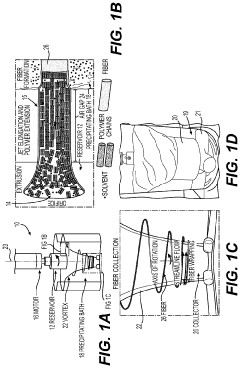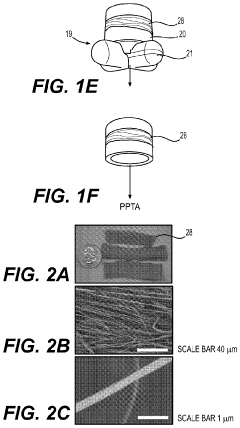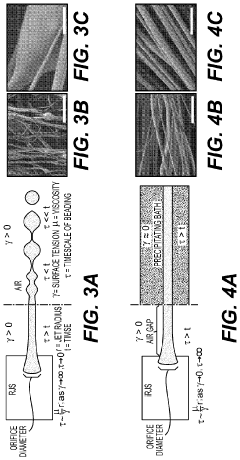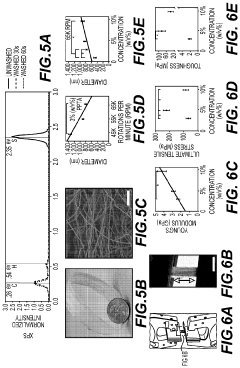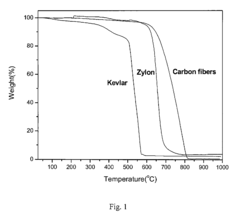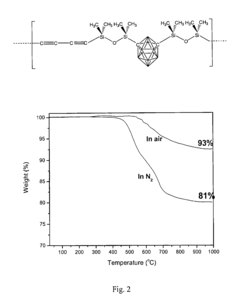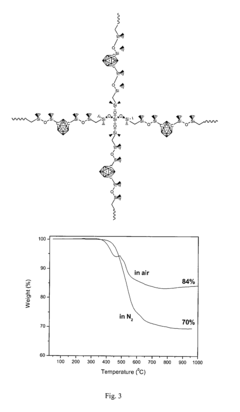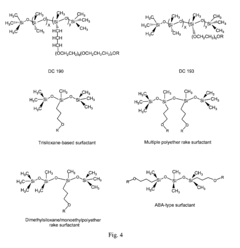Maximize Kevlar Efficiency in Extreme Environment Applications
JUL 10, 20259 MIN READ
Generate Your Research Report Instantly with AI Agent
Patsnap Eureka helps you evaluate technical feasibility & market potential.
Kevlar Evolution and Goals
Kevlar, a high-strength synthetic fiber developed by DuPont in the 1960s, has revolutionized numerous industries with its exceptional properties. Since its inception, Kevlar has undergone significant evolution, driven by the ever-increasing demands for stronger, lighter, and more versatile materials in extreme environments.
The development of Kevlar began with the goal of creating a lightweight, high-strength fiber for use in tires. However, its potential quickly expanded beyond this initial application. Over the years, researchers and engineers have continuously refined Kevlar's properties, focusing on enhancing its strength-to-weight ratio, heat resistance, and durability in harsh conditions.
One of the key milestones in Kevlar's evolution was the introduction of different variants, such as Kevlar 29 and Kevlar 49, each tailored for specific applications. These advancements allowed for the material's expansion into diverse fields, including aerospace, military, and personal protection equipment.
In recent years, the focus has shifted towards maximizing Kevlar's efficiency in extreme environment applications. This includes improving its performance under high temperatures, corrosive conditions, and intense mechanical stress. Researchers are exploring ways to enhance Kevlar's molecular structure and develop hybrid materials that combine Kevlar with other advanced substances to achieve superior properties.
The current goals for Kevlar development in extreme environments are multifaceted. First, there is a push to increase its heat resistance, allowing it to maintain its structural integrity at even higher temperatures. This is crucial for applications in aerospace and industrial settings where materials are exposed to extreme heat.
Another key objective is to improve Kevlar's resistance to chemical degradation, particularly in highly corrosive environments. This would expand its use in chemical processing plants, oil and gas industries, and other sectors where materials are exposed to harsh chemicals.
Enhancing Kevlar's impact resistance and energy absorption capabilities is also a priority, especially for applications in ballistic protection and high-speed impact scenarios. Researchers are working on developing new weaving techniques and composite structures to maximize these properties.
Furthermore, there is a growing interest in making Kevlar more environmentally sustainable. This includes exploring bio-based precursors for Kevlar production and developing recycling methods to reduce its environmental footprint.
As we look to the future, the evolution of Kevlar in extreme environment applications will likely focus on nanotechnology integration, smart material capabilities, and further customization for specific extreme conditions. The ultimate goal is to create a new generation of Kevlar-based materials that can adapt and perform optimally in the most challenging environments, pushing the boundaries of what is possible in material science and engineering.
The development of Kevlar began with the goal of creating a lightweight, high-strength fiber for use in tires. However, its potential quickly expanded beyond this initial application. Over the years, researchers and engineers have continuously refined Kevlar's properties, focusing on enhancing its strength-to-weight ratio, heat resistance, and durability in harsh conditions.
One of the key milestones in Kevlar's evolution was the introduction of different variants, such as Kevlar 29 and Kevlar 49, each tailored for specific applications. These advancements allowed for the material's expansion into diverse fields, including aerospace, military, and personal protection equipment.
In recent years, the focus has shifted towards maximizing Kevlar's efficiency in extreme environment applications. This includes improving its performance under high temperatures, corrosive conditions, and intense mechanical stress. Researchers are exploring ways to enhance Kevlar's molecular structure and develop hybrid materials that combine Kevlar with other advanced substances to achieve superior properties.
The current goals for Kevlar development in extreme environments are multifaceted. First, there is a push to increase its heat resistance, allowing it to maintain its structural integrity at even higher temperatures. This is crucial for applications in aerospace and industrial settings where materials are exposed to extreme heat.
Another key objective is to improve Kevlar's resistance to chemical degradation, particularly in highly corrosive environments. This would expand its use in chemical processing plants, oil and gas industries, and other sectors where materials are exposed to harsh chemicals.
Enhancing Kevlar's impact resistance and energy absorption capabilities is also a priority, especially for applications in ballistic protection and high-speed impact scenarios. Researchers are working on developing new weaving techniques and composite structures to maximize these properties.
Furthermore, there is a growing interest in making Kevlar more environmentally sustainable. This includes exploring bio-based precursors for Kevlar production and developing recycling methods to reduce its environmental footprint.
As we look to the future, the evolution of Kevlar in extreme environment applications will likely focus on nanotechnology integration, smart material capabilities, and further customization for specific extreme conditions. The ultimate goal is to create a new generation of Kevlar-based materials that can adapt and perform optimally in the most challenging environments, pushing the boundaries of what is possible in material science and engineering.
Extreme Environment Demand
The demand for Kevlar in extreme environments has been steadily increasing across various industries due to its exceptional strength-to-weight ratio and heat-resistant properties. In aerospace applications, Kevlar composites are sought after for their ability to withstand high temperatures and pressures encountered during atmospheric re-entry and hypersonic flight. The material's resistance to thermal degradation makes it ideal for heat shields and structural components in spacecraft and satellites.
The defense sector has shown a growing interest in Kevlar for personal protective equipment capable of withstanding extreme conditions. Military operations in harsh environments, from arctic to desert terrains, require gear that can maintain its protective qualities under severe temperature fluctuations and abrasive conditions. This has led to increased demand for Kevlar-reinforced clothing, helmets, and vehicle armor.
In the oil and gas industry, deep-sea exploration and drilling operations face extreme pressures and corrosive environments. Kevlar-reinforced hoses, cables, and structural components are in high demand for their ability to maintain integrity under these challenging conditions. The material's resistance to chemical degradation also makes it valuable in handling corrosive substances encountered in offshore operations.
The renewable energy sector, particularly wind energy, has seen a surge in demand for Kevlar composites. Wind turbine blades operating in offshore environments are exposed to salt spray, high winds, and temperature extremes. Kevlar's durability and fatigue resistance make it an attractive material for extending the lifespan of these critical components.
Firefighting and emergency response services require equipment that can withstand intense heat and flame exposure. Kevlar's heat-resistant properties have led to increased adoption in protective gear, hoses, and structural reinforcements for vehicles used in extreme fire scenarios.
The automotive racing industry, especially in endurance and high-performance categories, has shown growing interest in Kevlar for its ability to maintain structural integrity under extreme heat and stress. From brake components to body panels, the material's lightweight and heat-resistant qualities are highly valued in pushing the limits of vehicle performance.
As climate change leads to more frequent extreme weather events, there is an emerging demand for Kevlar in disaster-resistant construction materials. Its use in reinforcing structures to withstand hurricanes, tornadoes, and other severe weather conditions is gaining traction in vulnerable regions.
The defense sector has shown a growing interest in Kevlar for personal protective equipment capable of withstanding extreme conditions. Military operations in harsh environments, from arctic to desert terrains, require gear that can maintain its protective qualities under severe temperature fluctuations and abrasive conditions. This has led to increased demand for Kevlar-reinforced clothing, helmets, and vehicle armor.
In the oil and gas industry, deep-sea exploration and drilling operations face extreme pressures and corrosive environments. Kevlar-reinforced hoses, cables, and structural components are in high demand for their ability to maintain integrity under these challenging conditions. The material's resistance to chemical degradation also makes it valuable in handling corrosive substances encountered in offshore operations.
The renewable energy sector, particularly wind energy, has seen a surge in demand for Kevlar composites. Wind turbine blades operating in offshore environments are exposed to salt spray, high winds, and temperature extremes. Kevlar's durability and fatigue resistance make it an attractive material for extending the lifespan of these critical components.
Firefighting and emergency response services require equipment that can withstand intense heat and flame exposure. Kevlar's heat-resistant properties have led to increased adoption in protective gear, hoses, and structural reinforcements for vehicles used in extreme fire scenarios.
The automotive racing industry, especially in endurance and high-performance categories, has shown growing interest in Kevlar for its ability to maintain structural integrity under extreme heat and stress. From brake components to body panels, the material's lightweight and heat-resistant qualities are highly valued in pushing the limits of vehicle performance.
As climate change leads to more frequent extreme weather events, there is an emerging demand for Kevlar in disaster-resistant construction materials. Its use in reinforcing structures to withstand hurricanes, tornadoes, and other severe weather conditions is gaining traction in vulnerable regions.
Kevlar Limitations
Despite its remarkable properties, Kevlar faces several limitations when applied in extreme environments, which can impact its efficiency and performance. One of the primary challenges is its susceptibility to degradation under prolonged exposure to ultraviolet (UV) radiation. In outdoor applications or environments with high UV exposure, Kevlar's molecular structure can be compromised, leading to a reduction in tensile strength and overall durability over time.
Temperature extremes also pose significant challenges for Kevlar. While it maintains its strength at low temperatures, high-temperature environments can cause the material to soften and lose its mechanical properties. This thermal sensitivity limits its use in applications where consistent performance across a wide temperature range is crucial, such as in aerospace or certain industrial settings.
Moisture absorption is another limitation of Kevlar, particularly in humid or wet environments. The material can absorb up to 3-4% of its weight in water, which can lead to dimensional changes and potentially affect its mechanical properties. This characteristic necessitates careful consideration in applications where moisture exposure is likely, such as marine environments or outdoor gear.
Chemical resistance is a complex aspect of Kevlar's performance. While it exhibits good resistance to many chemicals, it is vulnerable to strong acids and bases. This vulnerability can be problematic in industrial applications where exposure to corrosive substances is possible, limiting its use in certain chemical processing or handling scenarios.
Kevlar's high strength-to-weight ratio, while generally advantageous, can be a limitation in applications requiring high compressive strength. The material's anisotropic nature means it performs exceptionally well under tensile loads but is less effective in resisting compressive forces. This characteristic can restrict its use in structural applications where compressive strength is as critical as tensile strength.
The manufacturing process of Kevlar also presents limitations in terms of shaping and forming the material. Unlike metals or thermoplastics, Kevlar cannot be easily molded or thermoformed into complex shapes. This constraint can limit design flexibility and increase manufacturing complexity for certain applications, potentially impacting cost-effectiveness in production.
Lastly, the cost of Kevlar remains a significant factor limiting its widespread adoption in various applications. Its complex manufacturing process and the specialized equipment required contribute to a higher price point compared to many alternative materials. This cost factor often necessitates a careful cost-benefit analysis when considering Kevlar for new applications, particularly in price-sensitive markets or large-scale implementations.
Temperature extremes also pose significant challenges for Kevlar. While it maintains its strength at low temperatures, high-temperature environments can cause the material to soften and lose its mechanical properties. This thermal sensitivity limits its use in applications where consistent performance across a wide temperature range is crucial, such as in aerospace or certain industrial settings.
Moisture absorption is another limitation of Kevlar, particularly in humid or wet environments. The material can absorb up to 3-4% of its weight in water, which can lead to dimensional changes and potentially affect its mechanical properties. This characteristic necessitates careful consideration in applications where moisture exposure is likely, such as marine environments or outdoor gear.
Chemical resistance is a complex aspect of Kevlar's performance. While it exhibits good resistance to many chemicals, it is vulnerable to strong acids and bases. This vulnerability can be problematic in industrial applications where exposure to corrosive substances is possible, limiting its use in certain chemical processing or handling scenarios.
Kevlar's high strength-to-weight ratio, while generally advantageous, can be a limitation in applications requiring high compressive strength. The material's anisotropic nature means it performs exceptionally well under tensile loads but is less effective in resisting compressive forces. This characteristic can restrict its use in structural applications where compressive strength is as critical as tensile strength.
The manufacturing process of Kevlar also presents limitations in terms of shaping and forming the material. Unlike metals or thermoplastics, Kevlar cannot be easily molded or thermoformed into complex shapes. This constraint can limit design flexibility and increase manufacturing complexity for certain applications, potentially impacting cost-effectiveness in production.
Lastly, the cost of Kevlar remains a significant factor limiting its widespread adoption in various applications. Its complex manufacturing process and the specialized equipment required contribute to a higher price point compared to many alternative materials. This cost factor often necessitates a careful cost-benefit analysis when considering Kevlar for new applications, particularly in price-sensitive markets or large-scale implementations.
Current Kevlar Solutions
01 Kevlar-reinforced composite materials
Kevlar fibers are incorporated into various composite materials to enhance their strength, durability, and impact resistance. These composites find applications in protective gear, aerospace components, and automotive parts, improving overall efficiency and performance.- Improved Kevlar fiber composition: Enhancements to Kevlar fiber composition to increase its efficiency, including modifications to the polymer structure or the addition of reinforcing agents. These improvements can lead to better strength, durability, and heat resistance of Kevlar-based materials.
- Kevlar-based composite materials: Development of composite materials incorporating Kevlar fibers to enhance overall material properties. These composites can combine the high strength and low weight of Kevlar with other materials to create more efficient and versatile products for various applications.
- Manufacturing processes for efficient Kevlar production: Innovative manufacturing techniques and processes to improve the efficiency of Kevlar production. This includes optimizing spinning methods, heat treatment processes, and other production steps to enhance the quality and properties of Kevlar fibers.
- Kevlar applications in protective gear: Utilization of Kevlar in the design and manufacture of high-performance protective gear. This includes body armor, helmets, and other safety equipment that benefit from Kevlar's exceptional strength-to-weight ratio and impact resistance.
- Kevlar efficiency in aerospace and automotive industries: Implementation of Kevlar-based materials in aerospace and automotive applications to improve fuel efficiency, reduce weight, and enhance structural integrity. This includes the use of Kevlar in aircraft components, vehicle parts, and other transportation-related applications.
02 Kevlar-based protective equipment
Kevlar is utilized in the manufacturing of protective equipment such as bulletproof vests, helmets, and gloves. The high tensile strength and lightweight properties of Kevlar contribute to improved efficiency in personal protection and safety gear.Expand Specific Solutions03 Kevlar in high-performance textiles
Kevlar fibers are integrated into high-performance textiles to create durable, heat-resistant, and cut-resistant fabrics. These textiles are used in various applications, including firefighting gear, industrial workwear, and sports equipment, enhancing efficiency and safety in demanding environments.Expand Specific Solutions04 Kevlar-enhanced structural components
Kevlar is used to reinforce structural components in buildings, bridges, and other infrastructure projects. The addition of Kevlar fibers improves the strength-to-weight ratio, corrosion resistance, and overall durability of these structures, leading to increased efficiency and longevity.Expand Specific Solutions05 Kevlar in aerospace and automotive applications
Kevlar is employed in aerospace and automotive industries to create lightweight, high-strength components. Its use in aircraft fuselages, car body panels, and other vehicle parts contributes to improved fuel efficiency, reduced emissions, and enhanced performance in transportation systems.Expand Specific Solutions
Key Kevlar Manufacturers
The competition landscape for maximizing Kevlar efficiency in extreme environment applications is characterized by a mature market with significant potential for growth. The industry is in a phase of advanced development, with established players and ongoing research efforts. The global market size for high-performance fibers, including Kevlar, is substantial and expected to expand further due to increasing demand in aerospace, defense, and industrial sectors. Technologically, companies like DuPont (Kevlar's inventor), Teijin, and Honeywell are at the forefront, with research institutions such as Donghua University, Nanjing University of Science & Technology, and Harbin Institute of Technology contributing to advancements. The Boeing Company and Rolls-Royce Corp. are likely end-users driving innovation in extreme environment applications.
Rolls-Royce Corp.
Technical Solution: Rolls-Royce has focused on maximizing Kevlar efficiency in extreme environments, particularly for aircraft engine components. Their approach involves a hybrid composite system that integrates Kevlar with advanced ceramic materials[2]. This combination leverages Kevlar's high tensile strength and lightweight properties with ceramics' heat resistance. Rolls-Royce has developed a proprietary weaving technique that allows for three-dimensional Kevlar structures, enhancing the material's ability to withstand multi-directional stresses in extreme conditions[4]. Additionally, they have implemented a novel coating technology that further protects the Kevlar fibers from degradation in high-temperature environments, extending the material's operational lifespan[6].
Strengths: Excellent heat resistance and durability, ideal for aircraft engine applications. Weaknesses: Complex manufacturing process and higher costs compared to traditional materials.
The Boeing Co.
Technical Solution: Boeing has developed advanced Kevlar composites for extreme environment applications, particularly in aerospace. Their approach involves a proprietary layering technique that combines Kevlar fibers with other high-performance materials to create a multi-functional composite[1]. This composite is designed to withstand extreme temperatures, from the cold of high altitudes to the heat of re-entry. Boeing's method includes a specialized resin system that enhances the Kevlar's resistance to thermal cycling and improves its overall durability[3]. The company has also implemented a nano-scale surface treatment on the Kevlar fibers, which significantly increases the interfacial bonding between the fibers and the matrix, resulting in improved mechanical properties and environmental resistance[5].
Strengths: Excellent thermal and mechanical properties, suitable for aerospace applications. Weaknesses: High production costs and complex manufacturing process.
Kevlar Innovations
Polymeric fiber materials for thermal and mechanical protection and methods of making
PatentPendingUS20220380943A1
Innovation
- Development of para-aramid polymeric fibers with a diameter range of 300 nm to 3 μm and high length-to-diameter aspect ratios, exhibiting a combination of high Young's modulus for mechanical protection and low thermal conductivity for thermal insulation, achieved through an immersion Rotary Jet-Spinning process using a solution of para-aramid polymer, sulfuric acid, and dimethylsulfoxide.
Coating of organic fibers with siloxane-carborane polymers
PatentActiveUS7705100B2
Innovation
- Application of a siloxane-carborane polymer coating on these fibers, which forms a thermo-oxidatively stable layer that protects against oxygen and moisture, using hydrosilation reactions to create crosslinked networks that maintain fiber flexibility and can withstand temperatures exceeding 1500°C.
Environmental Impact
The environmental impact of maximizing Kevlar efficiency in extreme environment applications is a critical consideration that extends beyond performance metrics. Kevlar, a high-strength synthetic fiber, has been widely used in various extreme conditions due to its exceptional properties. However, its production and application can have significant environmental implications.
The manufacturing process of Kevlar involves energy-intensive procedures and the use of potentially harmful chemicals. As efforts to maximize its efficiency in extreme environments intensify, there may be an increased demand for production, leading to higher energy consumption and chemical usage. This could result in elevated greenhouse gas emissions and potential chemical waste, impacting air and water quality in manufacturing regions.
On the positive side, the enhanced efficiency of Kevlar in extreme environments could lead to reduced material consumption over time. More durable and efficient Kevlar applications may require less frequent replacement, potentially decreasing the overall environmental footprint of products that utilize this material. This longevity factor is particularly relevant in harsh environments where material degradation is typically accelerated.
The disposal of Kevlar products at the end of their lifecycle presents another environmental challenge. While Kevlar itself is not biodegradable, research into recycling methods has shown promise. Improved efficiency in extreme environments may necessitate the development of more advanced recycling techniques to handle these specialized materials, potentially driving innovation in sustainable waste management practices.
In applications such as protective gear for firefighters or equipment for oil spill cleanup, the environmental impact of Kevlar usage becomes more complex. While its use may lead to improved safety and efficiency in handling environmental disasters, the production and disposal of these specialized items require careful consideration to minimize negative ecological effects.
The pursuit of maximizing Kevlar efficiency may also drive research into bio-based alternatives or hybrid materials that combine Kevlar's strength with more environmentally friendly components. This could potentially lead to breakthroughs in sustainable material science, balancing high performance with reduced environmental impact.
As global environmental regulations become more stringent, manufacturers and researchers focusing on Kevlar efficiency in extreme environments will need to prioritize eco-friendly production methods and life-cycle assessments. This may include exploring cleaner synthesis processes, reducing water usage in manufacturing, and developing closed-loop recycling systems to minimize waste.
The manufacturing process of Kevlar involves energy-intensive procedures and the use of potentially harmful chemicals. As efforts to maximize its efficiency in extreme environments intensify, there may be an increased demand for production, leading to higher energy consumption and chemical usage. This could result in elevated greenhouse gas emissions and potential chemical waste, impacting air and water quality in manufacturing regions.
On the positive side, the enhanced efficiency of Kevlar in extreme environments could lead to reduced material consumption over time. More durable and efficient Kevlar applications may require less frequent replacement, potentially decreasing the overall environmental footprint of products that utilize this material. This longevity factor is particularly relevant in harsh environments where material degradation is typically accelerated.
The disposal of Kevlar products at the end of their lifecycle presents another environmental challenge. While Kevlar itself is not biodegradable, research into recycling methods has shown promise. Improved efficiency in extreme environments may necessitate the development of more advanced recycling techniques to handle these specialized materials, potentially driving innovation in sustainable waste management practices.
In applications such as protective gear for firefighters or equipment for oil spill cleanup, the environmental impact of Kevlar usage becomes more complex. While its use may lead to improved safety and efficiency in handling environmental disasters, the production and disposal of these specialized items require careful consideration to minimize negative ecological effects.
The pursuit of maximizing Kevlar efficiency may also drive research into bio-based alternatives or hybrid materials that combine Kevlar's strength with more environmentally friendly components. This could potentially lead to breakthroughs in sustainable material science, balancing high performance with reduced environmental impact.
As global environmental regulations become more stringent, manufacturers and researchers focusing on Kevlar efficiency in extreme environments will need to prioritize eco-friendly production methods and life-cycle assessments. This may include exploring cleaner synthesis processes, reducing water usage in manufacturing, and developing closed-loop recycling systems to minimize waste.
Safety Regulations
Safety regulations play a crucial role in maximizing Kevlar efficiency in extreme environment applications. These regulations ensure that Kevlar-based products and systems meet stringent safety standards, protecting both users and the environment. The implementation of comprehensive safety protocols is essential for maintaining the integrity and performance of Kevlar materials under challenging conditions.
Regulatory bodies such as the Occupational Safety and Health Administration (OSHA) and the European Agency for Safety and Health at Work (EU-OSHA) have established guidelines specific to Kevlar usage in extreme environments. These guidelines cover various aspects, including material handling, storage, and disposal procedures. Compliance with these regulations is mandatory for manufacturers and end-users alike, ensuring consistent safety standards across industries.
One key area of focus in safety regulations is the proper selection and use of personal protective equipment (PPE) incorporating Kevlar. This includes specialized clothing, gloves, and helmets designed to withstand extreme temperatures, chemical exposure, and high-impact forces. Manufacturers must adhere to strict testing protocols to certify their Kevlar-based PPE products, ensuring they meet or exceed the required safety standards for specific extreme environment applications.
Safety regulations also address the importance of regular maintenance and inspection of Kevlar-based equipment. This includes guidelines for assessing wear and tear, identifying potential weak points, and implementing replacement schedules. By following these protocols, organizations can maximize the lifespan and effectiveness of Kevlar materials while minimizing the risk of equipment failure in critical situations.
Environmental considerations are another significant aspect of safety regulations for Kevlar in extreme environments. Guidelines have been established to minimize the ecological impact of Kevlar production, use, and disposal. These regulations promote sustainable practices, such as recycling and proper waste management, to reduce the environmental footprint of Kevlar applications.
Training and education requirements form an integral part of safety regulations. Personnel working with Kevlar in extreme environments must undergo specialized training programs to understand the material's properties, limitations, and proper handling techniques. These programs also cover emergency response procedures and risk assessment methodologies specific to Kevlar applications in challenging conditions.
Continuous improvement and adaptation of safety regulations are essential to keep pace with technological advancements in Kevlar applications. Regulatory bodies regularly review and update their guidelines based on new research findings, incident reports, and emerging best practices. This dynamic approach ensures that safety regulations remain relevant and effective in maximizing Kevlar efficiency across various extreme environment applications.
Regulatory bodies such as the Occupational Safety and Health Administration (OSHA) and the European Agency for Safety and Health at Work (EU-OSHA) have established guidelines specific to Kevlar usage in extreme environments. These guidelines cover various aspects, including material handling, storage, and disposal procedures. Compliance with these regulations is mandatory for manufacturers and end-users alike, ensuring consistent safety standards across industries.
One key area of focus in safety regulations is the proper selection and use of personal protective equipment (PPE) incorporating Kevlar. This includes specialized clothing, gloves, and helmets designed to withstand extreme temperatures, chemical exposure, and high-impact forces. Manufacturers must adhere to strict testing protocols to certify their Kevlar-based PPE products, ensuring they meet or exceed the required safety standards for specific extreme environment applications.
Safety regulations also address the importance of regular maintenance and inspection of Kevlar-based equipment. This includes guidelines for assessing wear and tear, identifying potential weak points, and implementing replacement schedules. By following these protocols, organizations can maximize the lifespan and effectiveness of Kevlar materials while minimizing the risk of equipment failure in critical situations.
Environmental considerations are another significant aspect of safety regulations for Kevlar in extreme environments. Guidelines have been established to minimize the ecological impact of Kevlar production, use, and disposal. These regulations promote sustainable practices, such as recycling and proper waste management, to reduce the environmental footprint of Kevlar applications.
Training and education requirements form an integral part of safety regulations. Personnel working with Kevlar in extreme environments must undergo specialized training programs to understand the material's properties, limitations, and proper handling techniques. These programs also cover emergency response procedures and risk assessment methodologies specific to Kevlar applications in challenging conditions.
Continuous improvement and adaptation of safety regulations are essential to keep pace with technological advancements in Kevlar applications. Regulatory bodies regularly review and update their guidelines based on new research findings, incident reports, and emerging best practices. This dynamic approach ensures that safety regulations remain relevant and effective in maximizing Kevlar efficiency across various extreme environment applications.
Unlock deeper insights with Patsnap Eureka Quick Research — get a full tech report to explore trends and direct your research. Try now!
Generate Your Research Report Instantly with AI Agent
Supercharge your innovation with Patsnap Eureka AI Agent Platform!
